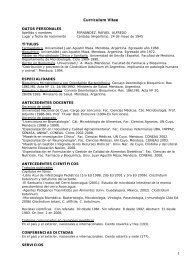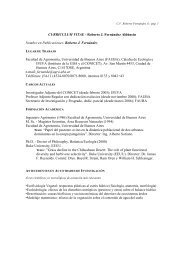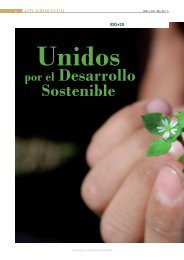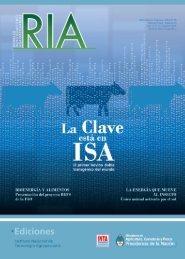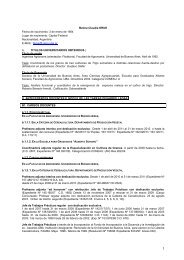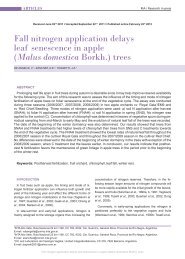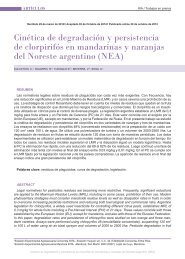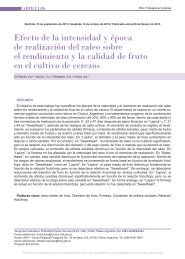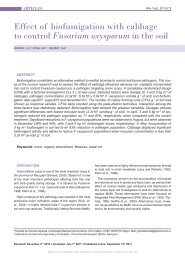Abril 2011, Arg<strong>en</strong>tina 99Líneas de girasol de la EEA PergaminoGONZÁLEZ, J. 1 ; MANCUSO, N. 1 ; LUDUEÑA, P. 1RESUMENSe analizaron tres grupos de líneas de girasol (Helianthus annuus) de la EEA Pergamino del <strong>INTA</strong>. Grupo 1:líneas derivadas de los compuestos P1, P2, P4, PGRK y KLM liberadas <strong>en</strong> la década del 90. Grupo 2: líneas GPlogradas de cruzas <strong>en</strong>tre las del grupo 1 con otras fu<strong>en</strong>tes, liberadas a partir del 2001. Grupo 3: líneas AO (cont<strong>en</strong>idode oleico > 80%) derivadas de materiales del North Dakota y de cruzas con materiales locales. Se analizaronlos sigui<strong>en</strong>tes caracteres: número de aqu<strong>en</strong>ios por capítulo, peso de 100 aqu<strong>en</strong>ios, porc<strong>en</strong>taje de pepita yaceite, altura de planta y número de días desde siembra a floración. El objetivo fue evaluar la variabilidad del germoplasma<strong>en</strong>tre grupos y las asociaciones <strong>en</strong>tre caracteres d<strong>en</strong>tro de cada grupo para id<strong>en</strong>tificar el idiotipo y lascaracterísticas difer<strong>en</strong>ciales. El efecto de la selección se manifestó claram<strong>en</strong>te al comparar los grupos. En elGrupo 1, la selección se efectuó principalm<strong>en</strong>te por r<strong>en</strong>dimi<strong>en</strong>to de semilla y, <strong>en</strong> los Grupos 2 y 3 se dirigió a lamejora del cont<strong>en</strong>ido porc<strong>en</strong>tual de aceite y cont<strong>en</strong>ido porc<strong>en</strong>tual de oleico, respectivam<strong>en</strong>te. Las líneas del Grupo2 y Grupo 3 (AO) superaron <strong>en</strong> cont<strong>en</strong>ido de aceite a las del Grupo 1, las cuales fueron de mayor altura y pesode aqu<strong>en</strong>io. D<strong>en</strong>tro de cada grupo se id<strong>en</strong>tificaron de 4 a 6 subgrupos caracterizados por los objetivos del mejorami<strong>en</strong>toy difer<strong>en</strong>ciándose líneas indep<strong>en</strong>di<strong>en</strong>tes derivadas por objetivos de selección indirecta. El germoplasmaevaluado podría incorporarse a difer<strong>en</strong>tes “backgrounds” g<strong>en</strong>éticos según los objetivos del mejorami<strong>en</strong>to.Palabras clave: Helianthus annuus, líneas de girasol, mejorami<strong>en</strong>to.ABSTRACTThree groups of sunflower (Helianthus annuus) lines from Pergamino Experim<strong>en</strong>tal Station, <strong>INTA</strong> (NationalInstitute of Agricultural Technology) 33º 53’S, 60º 35’ O were evaluated. The lines composing the first group(Group 1) were selected from P1, P2, P4, PGRK and KLM populations, released in the decade of the 90´s.Thesecond group (Group 2) included lines GP, derived from the crosses betwe<strong>en</strong> Group 1 and other sources, releasedafter 2001. The third group (Group 3) consisted of lines AO (oleic cont<strong>en</strong>t >80%) derived from crosses betwe<strong>en</strong>North Dakota materials and local lines. Height, days to flowering, weight and number of ach<strong>en</strong>es, perc<strong>en</strong>tageof oil, oleic acid, and kernel were analyzed. The objective was to evaluate the variability of the germplasmbetwe<strong>en</strong> groups and the associations among characters within each group, to id<strong>en</strong>tify the idiotype and differ<strong>en</strong>tialcharacteristics. Selection effect was clearly shown wh<strong>en</strong> groups were compared. Group 1 was selectedbased on seed yield and in groups 2 and 3 by the oil and oleic acid perc<strong>en</strong>tage cont<strong>en</strong>t respectively. The oil cont<strong>en</strong>tof lines of the groups 2 and 3 was higher than group 1. On the other hand, derived from group 1 were higherand weighter ach<strong>en</strong>es. Four to six sub-groups were id<strong>en</strong>tified within each group characterized themselvesby the objectives of breeding. Individual lines, derived by indirect selection, were id<strong>en</strong>tified. The available germplasmcould be included in differ<strong>en</strong>t g<strong>en</strong>etic backgrounds according to the objectives of the breeding program.Key words: Helianthus annuus; Sunflower lines; Breeding.1 Instituto Nacional de Tecnología Agropecuaria (<strong>INTA</strong>). Estación Experim<strong>en</strong>tal Agropecuaria Pergamino. C.C. 31 (2700) Pergamino, Arg<strong>en</strong>tina.Tel: +542477439023. E-mail: pergira@pergamino.inta.gov.arRecibido 14 de septiembre de 2010 // Aceptado 2 de febrero de 2011 // Publicado online 09 de marzoGONZÁLEZ, J. 1 ; MANCUSO, N. 1 ; LUDUEÑA, P. 1
100 ARTÍCULOS<strong>RIA</strong> / Vol. 37 N.À1INTRODUCCIÓNLa EEA Pergamino del <strong>INTA</strong> conduce un programa demejorami<strong>en</strong>to g<strong>en</strong>ético de Girasol con el objetivo g<strong>en</strong>eralde contribuir a increm<strong>en</strong>tar la competitividad del cultivomediante la mejora de atributos asociados con r<strong>en</strong>dimi<strong>en</strong>toy calidad.Desde 1939, el programa de mejorami<strong>en</strong>to de girasol dela EEA Pergamino fue liberando germoplasma (compuestos,variedades, líneas, etc.) de difer<strong>en</strong>tes característicasf<strong>en</strong>ológicas, agronómicas, sanitarias y de calidad industrial.En sus inicios el programa tuvo por objetivo el desarrollode variedades de polinización abierta a partir de poblacionesintroducidas por los inmigrantes adaptadas a lascondiciones locales (Bertero de Romano y Vázquez, 2003)complem<strong>en</strong>tándose con las introducciones del Ministeriode Agricultura, Ganadería y Pesca de la Nación dirigidas aincrem<strong>en</strong>tar el t<strong>en</strong>or de aceite. Con la aparición de laandro-esterilidad citoplasmática <strong>en</strong> la década del 70, seori<strong>en</strong>tó a la obt<strong>en</strong>ción de líneas <strong>en</strong>docriadas para el desarrollode híbridos (González y Mancuso, 2004).La exist<strong>en</strong>cia de variabilidad es una condición indisp<strong>en</strong>sablepara el desarrollo de un programa de mejorami<strong>en</strong>tog<strong>en</strong>ético. La información prov<strong>en</strong>i<strong>en</strong>te de la descripciónde cultivares de girasol, analizada a través demétodos adecuados, permite caracterizar la variabilidaddel germoplasma.Fernández Martínez y Domínguez Giménez (1985)<strong>en</strong>contraron gran variabilidad <strong>en</strong> cont<strong>en</strong>ido de aceite,peso de 100 semillas, porc<strong>en</strong>taje de cáscara, cont<strong>en</strong>idode aceite <strong>en</strong> pepita y composición de ácidos grasos, analizandomuestras de una colección mundial de girasol.Los autores <strong>en</strong>contraron correlación negativa <strong>en</strong>tre porc<strong>en</strong>tajede aceite y porc<strong>en</strong>taje de cáscara y no <strong>en</strong>contraronsignificación estadística <strong>en</strong> la correlación <strong>en</strong>tre pesode semilla y su cont<strong>en</strong>ido de aceite, mi<strong>en</strong>tras que Fick etal. (1974) <strong>en</strong>contraron correlación negativa <strong>en</strong>tre cont<strong>en</strong>idode aceite y peso de semilla.A su vez, Álvarez et al. (1991), <strong>en</strong> un estudio depoblaciones de girasol de difer<strong>en</strong>tes oríg<strong>en</strong>es, informaroncorrelación negativa <strong>en</strong>tre ciclo a floración y númerode granos, mi<strong>en</strong>tras que Arango et al. (1995), analizandomuestras del banco de germoplasma de girasol,<strong>en</strong>contraron correlación positiva <strong>en</strong>tre cont<strong>en</strong>ido deaceite y porc<strong>en</strong>taje de pepa, pero no <strong>en</strong>contraroncorrelación significativa <strong>en</strong>tre cont<strong>en</strong>ido de aceite ypeso de semilla.Por su parte, Chikkadevaiah et al. (2002), <strong>en</strong> un estudiosobre líneas de girasol <strong>en</strong>contraron, que el cont<strong>en</strong>idode aceite se correlacionaba positivam<strong>en</strong>te con altura ypeso de semilla y Joksimovick et al. (2004), <strong>en</strong> un estudiosobre líneas e híbridos de girasol, obtuvieron correlaciónpositiva <strong>en</strong>tre cont<strong>en</strong>ido de aceite y peso de semilla.Por último, González et al. (2004) <strong>en</strong>contraron correlaciónnegativa <strong>en</strong>tre cont<strong>en</strong>ido de aceite y peso de semillay positiva <strong>en</strong>tre cont<strong>en</strong>ido de aceite y cont<strong>en</strong>ido de pepa.En este trabajo se analizan caracteres productivos,f<strong>en</strong>ológicos y de calidad industrial de varios grupos delíneas. Grupo 1: obt<strong>en</strong>idas <strong>en</strong>te los años 1980 y 1990,derivadas de los compuestos Pergamino, PGRK, KLM yde cruzas BXC, etc. Grupo 2: liberadas a partir del año2001 producto de cruzas <strong>en</strong>tre los materiales antiguos yotros de más reci<strong>en</strong>te aparición. Grupo 3: líneas con altocont<strong>en</strong>ido de oleico.El objetivo fue comparar los caracteres productivos,f<strong>en</strong>ológicos y de calidad industrial, <strong>en</strong>tre y d<strong>en</strong>tro de losdistintos grupos; detectar la variabilidad y asociaciones<strong>en</strong>tre los mismos, y su pot<strong>en</strong>cialidad para el logro de idiotiposcon características difer<strong>en</strong>ciales.MATE<strong>RIA</strong>LES Y MÉTODOSSe analizó la información prov<strong>en</strong>i<strong>en</strong>te de 75 líneasmant<strong>en</strong>edoras de girasol (Anexo: “Orig<strong>en</strong> de las líneas”)pert<strong>en</strong>eci<strong>en</strong>tes a los sigui<strong>en</strong>tes grupos: Grupo 1, líneasderivadas de los compuestos P1 (compuesto Pergamino1), P4 (compuesto Pergamino 4), P2 (compuestoPergamino 2), PGRK (Pozo G<strong>en</strong>ético Ruso por Klein) yKLM (Pozo G<strong>en</strong>ético Klein, Locales, Manfredi) obt<strong>en</strong>idas<strong>en</strong> la década del 90; Grupo 2, líneas GP (GirasolPergamino) prov<strong>en</strong>i<strong>en</strong>tes de cruzas <strong>en</strong>tre las del Grupo 1con otras fu<strong>en</strong>tes obt<strong>en</strong>idas a partir del 2001; Grupo 3,líneas AO de cont<strong>en</strong>ido de oleico mayor al 80% derivadasde materiales del North Dakota y de cruzas conmateriales locales.El análisis de los caracteres de las líneas se efectuócomo parte de la descripción de cultivares para el INASE(Instituto Nacional de Semillas) d<strong>en</strong>tro del programa demejorami<strong>en</strong>to de girasol de la EEA Pergamino. Las líneasfueron descriptas <strong>en</strong> distintos años suponi<strong>en</strong>do un efectoaño no significativo (se comparan con los valores de líneastestigo que fueron sembradas todos los años para usarlascomo refer<strong>en</strong>cia <strong>en</strong> la descripción). Las fechas de siembrafueron durante el mes de octubre considerándose normalespara la zona por su baja incid<strong>en</strong>cia sobre caracteresrelacionados con r<strong>en</strong>dimi<strong>en</strong>to y calidad. La parcela experim<strong>en</strong>talfue de un surco de 6m de largo x 0.7m <strong>en</strong>tre líneas,empleándose un diseño estadístico de bloques al azar con4 repeticiones. Las evaluaciones se hicieron <strong>en</strong> las campañas2001/02, 2003/04 y 2007/08.Se midieron, <strong>en</strong> 4 plantas de cada línea los sigui<strong>en</strong>tescaracteres: número de aqu<strong>en</strong>ios por capítulo, peso de100 aqu<strong>en</strong>ios, porc<strong>en</strong>taje de pepita, de aceite y de ácidooleico, altura de planta y número de días desde siembraa floración. En los dos últimos se tomó el promedio de laparcela.Líneas de girasol de la EEA Pergamino
- Page 7 and 8:
8 ACTUALIDAD EN I+DRIA / Vol. 37 N.
- Page 9 and 10:
10 ACTUALIDAD EN I+DRIA / Vol. 37 N
- Page 11 and 12:
12 ACTUALIDAD EN I+DRIA / Vol. 37 N
- Page 13 and 14:
14 ACTUALIDAD EN I+DRIA / Vol. 37 N
- Page 15 and 16:
16 ACTUALIDAD EN I+DRIA / Vol. 37 N
- Page 17 and 18:
18 ARTÍCULOSRIA / Vol. 37 N.À1Per
- Page 19:
20 ARTÍCULOSRIA / Vol. 37 N.À1Fig
- Page 22 and 23:
Abril 2011, Argentina 23Tabla 3. Va
- Page 24 and 25:
Abril 2011, Argentina 25publication
- Page 26 and 27:
Abril 2011, Argentina 27ABSTRACTA s
- Page 28 and 29:
Abril 2011, Argentina 29mientos, ca
- Page 30 and 31:
Abril 2011, Argentina 31Cuadro 2: A
- Page 32 and 33:
Abril 2011, Argentina 33Diagnóstic
- Page 34 and 35:
Abril 2011, Argentina 35encuestados
- Page 36 and 37:
Abril 2011, Argentina 37Contenido d
- Page 38 and 39:
Abril 2011, Argentina 39de rebaje,
- Page 40 and 41:
Abril 2011, Argentina 41Figura 3. C
- Page 42 and 43:
Abril 2011, Argentina 43Tabla 2. Co
- Page 44 and 45:
Abril 2011, Argentina 4525/02/2004)
- Page 46 and 47:
Abril 2011, Argentina 47was based o
- Page 48 and 49: Abril 2011, Argentina 49se obtenía
- Page 50 and 51: Abril 2011, Argentina 51Figura 5. R
- Page 52 and 53: Abril 2011, Argentina 53Technique.
- Page 54 and 55: Abril 2011, Argentina 55ABSTRACTThi
- Page 56 and 57: Abril 2011, Argentina 57Figura 1 y
- Page 58 and 59: Abril 2011, Argentina 59Tabla 3. N
- Page 60 and 61: Abril 2011, Argentina 61del fertili
- Page 62 and 63: Abril 2011, Argentina 63ABSTRACTThe
- Page 64 and 65: Abril 2011, Argentina 65de fósforo
- Page 66 and 67: Abril 2011, Argentina 67Figura 2a.F
- Page 68 and 69: Abril 2011, Argentina 69resultaron
- Page 70 and 71: Abril 2011, Argentina 71probablemen
- Page 72 and 73: Abril 2011, Argentina 73el tratamie
- Page 74 and 75: Abril 2011, Argentina 75Comparació
- Page 76 and 77: Abril 2011, Argentina 77de la estim
- Page 78 and 79: Abril 2011, Argentina 79Los valores
- Page 80 and 81: Abril 2011, Argentina 81Tabla 3: Co
- Page 82 and 83: Abril 2011, Argentina 83Figura 6: I
- Page 84 and 85: Abril 2011, Argentina 85Tabla 5bTab
- Page 86 and 87: Abril 2011, Argentina 87Se evaluaro
- Page 88 and 89: Abril 2011, Argentina 89RESULTADOS
- Page 90 and 91: Abril 2011, Argentina 91de trilha d
- Page 92 and 93: Abril 2011, Argentina 93INTRODUCCI
- Page 94 and 95: Abril 2011, Argentina 951.2. Rendim
- Page 96 and 97: Abril 2011, Argentina 97Tratamiento
- Page 100 and 101: Abril 2011, Argentina 101Se efectu
- Page 102 and 103: Abril 2011, Argentina 103ción de E
- Page 104 and 105: Abril 2011, Argentina 105La correla



